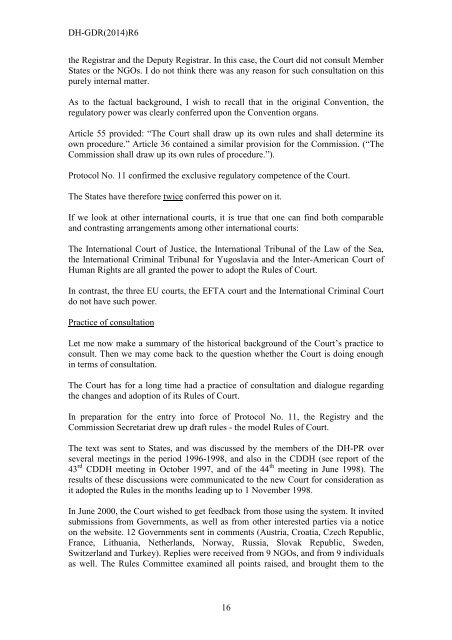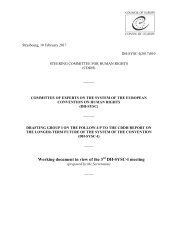DH-GDR(2014)R6_EN
DH-GDR(2014)R6_EN
DH-GDR(2014)R6_EN
You also want an ePaper? Increase the reach of your titles
YUMPU automatically turns print PDFs into web optimized ePapers that Google loves.
<strong>DH</strong>-<strong>GDR</strong>(<strong>2014</strong>)<strong>R6</strong><br />
the Registrar and the Deputy Registrar. In this case, the Court did not consult Member<br />
States or the NGOs. I do not think there was any reason for such consultation on this<br />
purely internal matter.<br />
As to the factual background, I wish to recall that in the original Convention, the<br />
regulatory power was clearly conferred upon the Convention organs.<br />
Article 55 provided: “The Court shall draw up its own rules and shall determine its<br />
own procedure.” Article 36 contained a similar provision for the Commission. (“The<br />
Commission shall draw up its own rules of procedure.”).<br />
Protocol No. 11 confirmed the exclusive regulatory competence of the Court.<br />
The States have therefore twice conferred this power on it.<br />
If we look at other international courts, it is true that one can find both comparable<br />
and contrasting arrangements among other international courts:<br />
The International Court of Justice, the International Tribunal of the Law of the Sea,<br />
the International Criminal Tribunal for Yugoslavia and the Inter-American Court of<br />
Human Rights are all granted the power to adopt the Rules of Court.<br />
In contrast, the three EU courts, the EFTA court and the International Criminal Court<br />
do not have such power.<br />
Practice of consultation<br />
Let me now make a summary of the historical background of the Court’s practice to<br />
consult. Then we may come back to the question whether the Court is doing enough<br />
in terms of consultation.<br />
The Court has for a long time had a practice of consultation and dialogue regarding<br />
the changes and adoption of its Rules of Court.<br />
In preparation for the entry into force of Protocol No. 11, the Registry and the<br />
Commission Secretariat drew up draft rules - the model Rules of Court.<br />
The text was sent to States, and was discussed by the members of the <strong>DH</strong>-PR over<br />
several meetings in the period 1996-1998, and also in the CD<strong>DH</strong> (see report of the<br />
43 rd CD<strong>DH</strong> meeting in October 1997, and of the 44 th meeting in June 1998). The<br />
results of these discussions were communicated to the new Court for consideration as<br />
it adopted the Rules in the months leading up to 1 November 1998.<br />
In June 2000, the Court wished to get feedback from those using the system. It invited<br />
submissions from Governments, as well as from other interested parties via a notice<br />
on the website. 12 Governments sent in comments (Austria, Croatia, Czech Republic,<br />
France, Lithuania, Netherlands, Norway, Russia, Slovak Republic, Sweden,<br />
Switzerland and Turkey). Replies were received from 9 NGOs, and from 9 individuals<br />
as well. The Rules Committee examined all points raised, and brought them to the<br />
16



